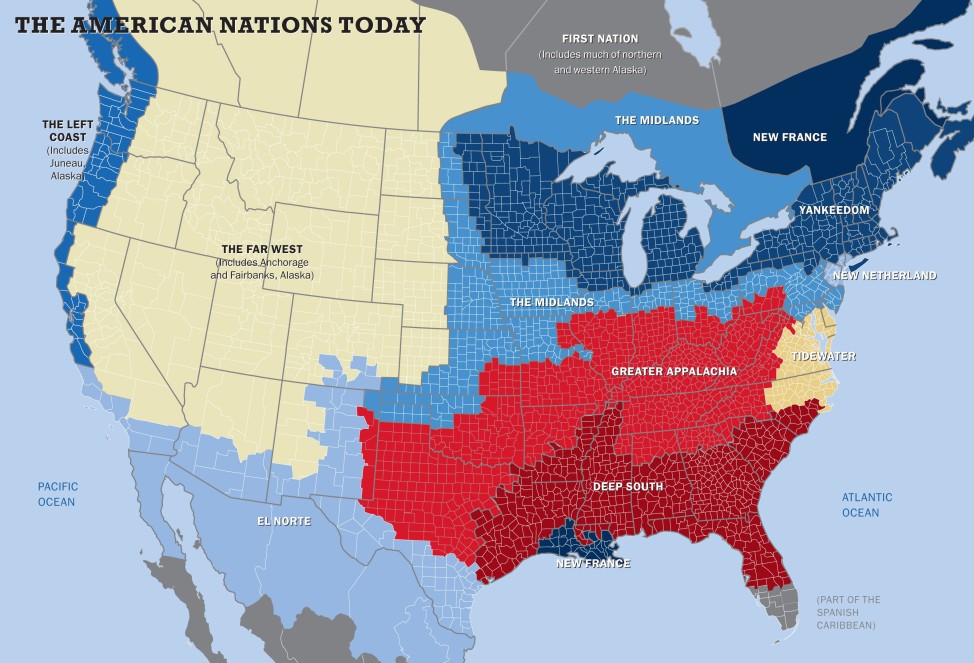
Graphic: Colin Woodward and Tufts/Brian Stauffer
Are the sometimes stark societal divisions in America rooted in the reality that, although the United States is one country, it is actually compromised of 11 nations with distinctly different cultures with their own values and viewpoints?
MORE ABOUT AMERICA
Wild West Ghost Town Emerges from Watery Grave
What Happens When Americans Tweet What They Eat
That’s the argument made by journalist Colin Woodard in his book, American Nations: A History of the Eleven Rival Regional Cultures in North America. Woodard says deeply held and divergent opinions on everything from abortion to gun control have deep historical roots. Woodard believes modern-day opinions in each of these nations were actually formed hundreds of years ago by the people who originally settled these regions.
For example, Woodard believes the southern part of the United States was shaped by the battle over slavery and today still resists any perceived efforts to increase federal powers.
“There’s never been one American culture but rather several Americas,” said Woodard. “The country was settled, not as a single enterprise, but by entirely separate groups of people founding separate colonial clusters with very different ideals and goals.”
Woodard says the children, grandchildren and great-grandchildren of the founders of these regions aren’t assimilating to an American culture, but to one of these regional cultures, which leads the overall ethos and characteristics of these nations to persist over time.
Here’s how Woodard describes each nation:
Yankeedom
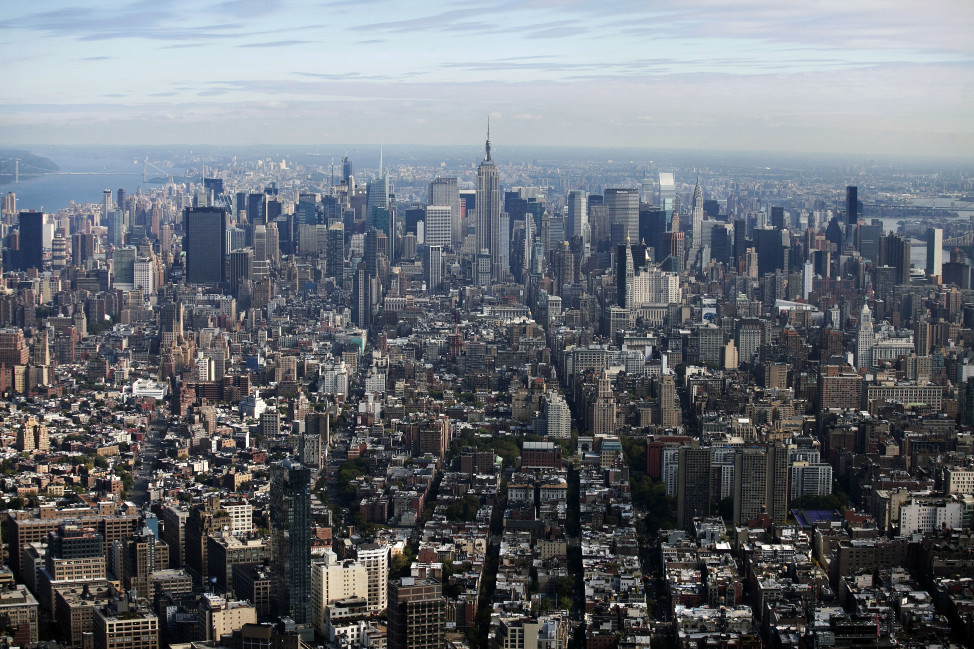
New York City belongs to New Netherland, according to Colin Woodard, author of “American Nations: A History of the Eleven Rival Regional Cultures in North America.” (AP Photo)
Encompassing the entire northeast north of New York City as well as parts of Michigan, Wisconsin, and Minnesota, Yankeedom was founded by radical Calvinists who put great emphasis on education, local political control, and the pursuit of the greater good of the community. Yankees have great faith in the potential of government to improve people’s lives.
New Netherland
It wasn’t there for long, but the seventeenth-century Dutch colony of New Netherland had a lasting impact on New York City and northern New Jersey. Woodard describes this global commercial trading society as multi-ethnic, multi-religious, speculative, materialistic, mercantile, and free trading, a “raucous, not entirely democratic city-state where no ethnic or religious group has ever truly been in charge”.
The Midlands
Woodard says the Midlands — comprised of parts of New Jersey, Pennsylvania, Ohio, Indiana, Illinois, Missouri, Iowa, Kansas, and Nebraska — are possibly the “most American” of the nations, having been settled by English Quakers who welcomed people of many nations and creeds to their utopian colonies. “Pluralistic and organized around the middle class, the Midlands spawned the culture of Middle America and the Heartland, where ethic and ideological purity has never been a priority, government has been seen as an unwelcome intrusion, and political opinion has been moderate, even apathetic.”
Tidewater
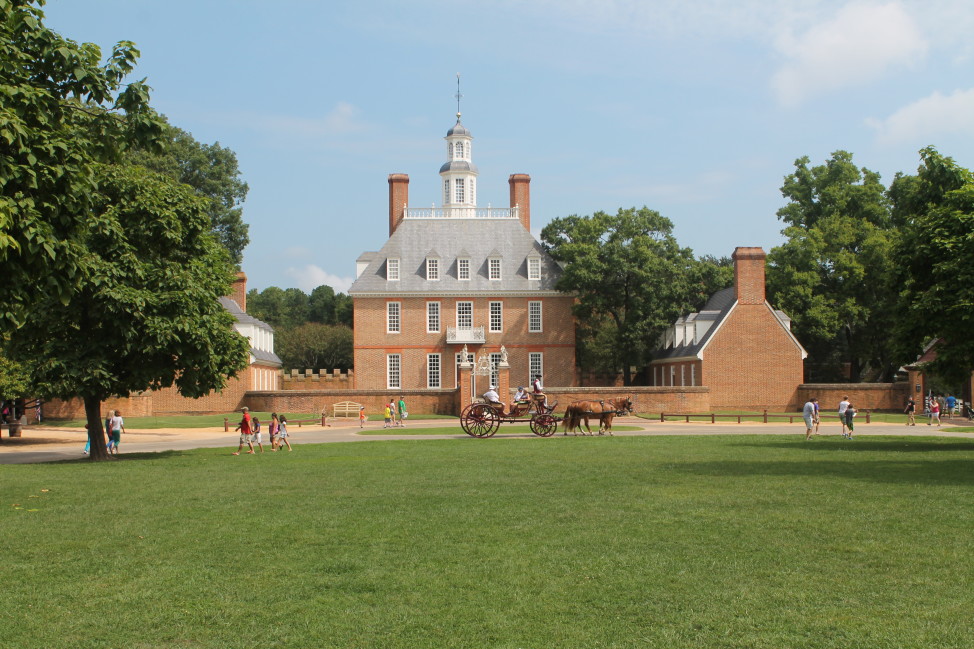
Colonial Williamsburg. Virginia is part of the fundamentally conservative Tidewater nation.
This area — encompassing parts of Virginia, Maryland, southern Delaware and northeastern North Carolina — was the most powerful region during the colonial period and the early days of the new republic. Fundamentally conservative, Tidewater places a high value on authority and tradition and little respect for equality or public participation in politics. Woodard says these attitudes are not surprising since this nation was founded by the younger sons of English gentry who aimed to “reproduce the semifeudal manorial society of the English countryside, where economic, political, and social affairs were run by and for landed aristocrats.”
Greater Appalachia
The people of this nation — including parts of Kentucky, Tennessee, West Virginia, Arkansas, Missouri, Oklahoma, Indiana, Illinois, and Texas — are often stereotyped as rednecks, hillbillies and “white trash”. Greater Appalachia was settled by “rough, bellicose settlers from the war-ravaged borderlands of Northern Ireland, northern England and the Scottish lowlands”, according to Woodard. Coming from a culture that fostered a warrior ethic and prized individual liberty, these “American Borderlanders despised Yankee teachers, Tidewater lords and Deep Southern aristocrats.” Large segments of the U.S. military have come from this combative culture, including Andrew Jackson, Davy Crockett and Douglas MacArthur.
The Deep South
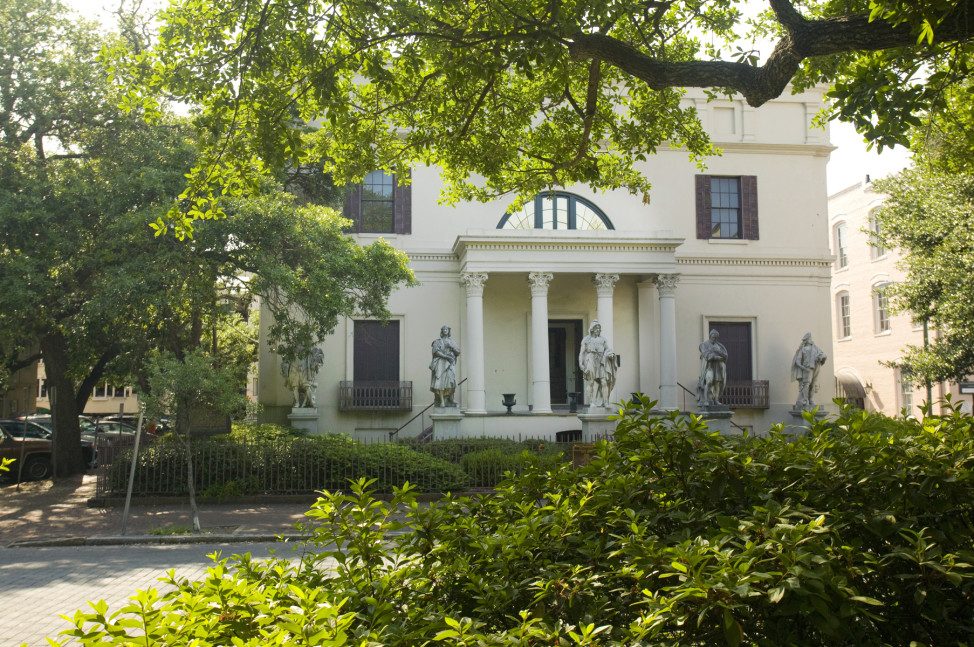
Georgia is part of Woodard’s Deep South region. (AP Photo)
Alabama, Florida, Mississippi, Texas, Georgia, and South Carolina make up this nation, which was established by Barbados slave lords as a slave society similar to one in the West Indies, a system “so cruel and despotic that it shocked even its seventeenth century English contemporaries”. The Deep South has historically been a stronghold of white supremacy, aristocratic privilege and a classic Republicanism where “democracy was a privilege of the few and enslavement the natural lot of many”.
New France
Centered around New Orleans, Louisiana, and the Canadian province of Quebec, this nation is down-to-earth, egalitarian and consensus-driven. New French culture blends northern French peasantry “with the tradition and values of the aboriginal people they encountered in northeastern North America”. Pollsters have found the New French to be the most liberal people in the country.
El Norte
Parts of Texas, Arizona, New Mexico, and California are in El Norte, which is composed of the borderlands of the Spanish-American empire. Woodard says El Norte — which spreads from the U.S.-Mexico border from 100 miles or more in either direction — is a place apart from the rest of the United States, where Hispanic language, culture and societal norms dominate. In El Norte, being independent, self-sufficient, adaptable and hard-working is valued above everything else.
The Left Coast
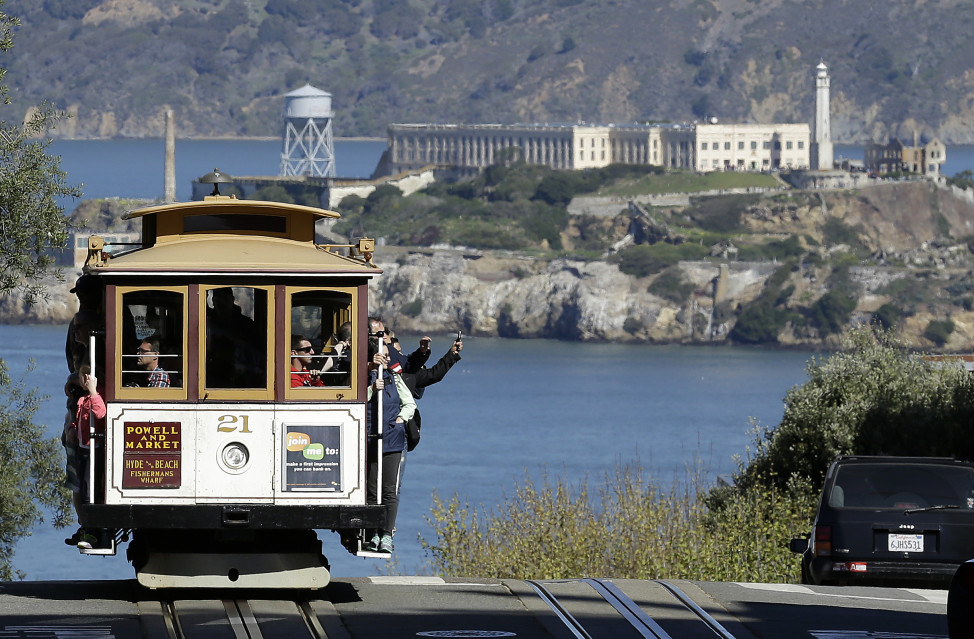
San Francisco, California, is a Left Coast city. (AP Photo)
This nation extends from Monterey, California, to Juneau, Alaska and includes four progressive big cities: San Francisco, Portland, Seattle and Vancouver. Originally colonized by merchants, missionaries and woodsmen from New England, as well as farmers, prospectors and fur traders from Greater Appalachia, the Left Coast has retained a strong sense of “New England intellectualism and idealism, even as it embraced a culture of individual fulfillment”. Today, the Left Coast combines the Yankee faith in good government and social reform with a commitment to individual self-exploration and discovery, according to Woodard.
The Far West
The high, dry and remote nature of the environment trumped ethnicity in the Far West, where harsh conditions meant most of the colonization was directed by large distant corporations in New York, Boston, Chicago, San Francisco, or the federal government because the railroads, heavy mining equipment, dams and irrigation systems were needed to colonize this vast region. Often exploited for the benefit of the nations on either seaboard, Woodard says this nation tends to revile the federal government for interfering with its affairs while still expecting generous federal payouts. Far West states include Idaho, Montana, Wyoming, Utah, Washington, Oregon, North Dakota, South Dakota, Colorado, Nevada, Utah, Nebraska, Kansas, Arizona, New Mexico, and California.
First Nation
This nation’s indigenous people still occupy this area and still retain the “cultural practices and knowledge that allow them to survive in the region” on their own terms. These are Native Americans who enjoy tribal sovereignty but most of this group is in Northern Canada.
Two nations, Yankeedom and the Deep South, which are polar opposites, have historically had outsized influence on the country as a whole and tend to be the “superpower” nations.
As people move around, one might assume the country would become more homogenous, but Woodard says the opposite occurs, with Americans becoming more polarized as they move to regions they identify with.
“That means, in essence, that we are self-sorting,” he said. “That when somebody has an opportunity to move…people tend to be moving to places where they feel more at home, where they are surrounded by like-minded individuals. That ends up with a self-sorting effect that ends up reinforcing the differences between these regional cultures.”
Woodard expects the characteristics of these cultures to remain fundamentally constant over the next century, a key reason he aspires to make more Americans aware of their forgotten past.
“We in North America, we’re a pretty amnesiatic people,” Woodard said. “A lot of these forces of our deeper history are affecting us in all sorts of ways and are handicapping our country’s political debates but, unlike other people in other parts of the world, we just don’t realize that because we tend not to know our history very well and be aware of these things.”
Woodward hopes a deeper understanding of the reasons behind strong geographic fissures in this country will help lay the foundation for a more meaningful political and social conversation in the United States.

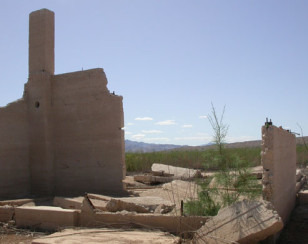

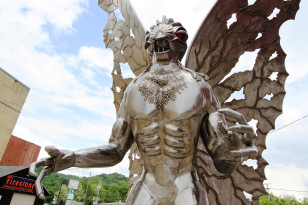
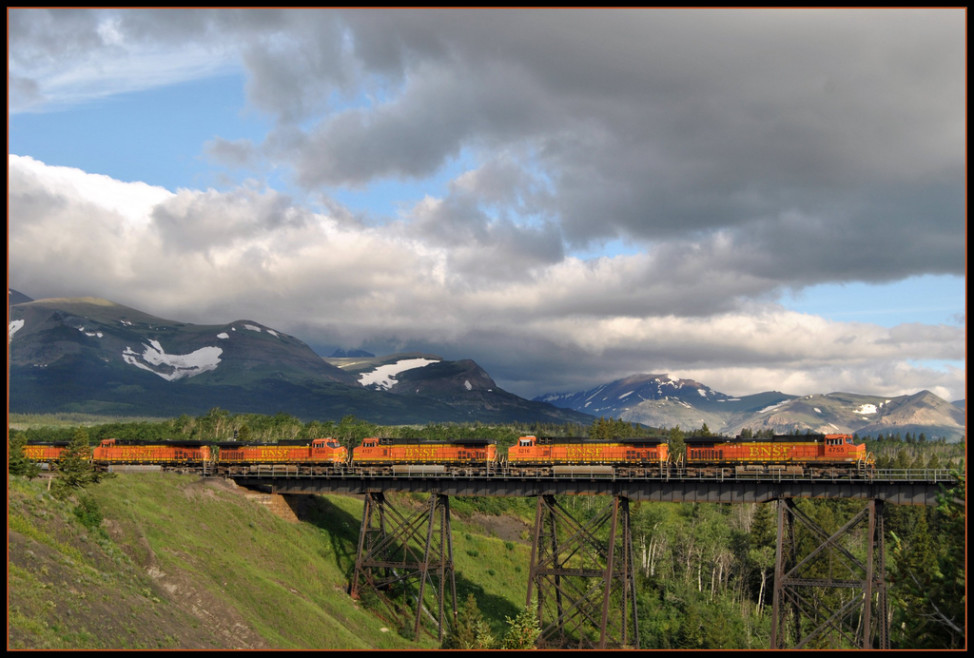

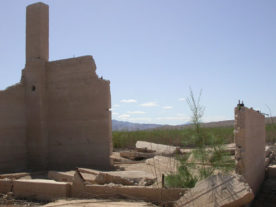
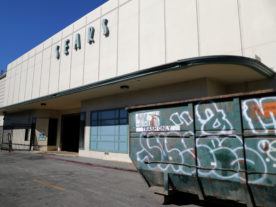
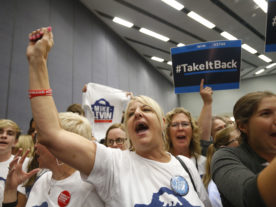


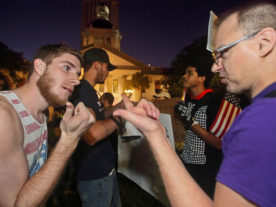

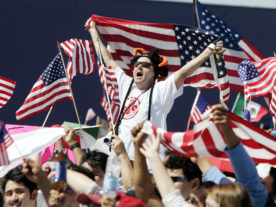
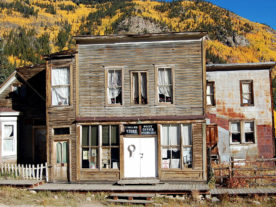
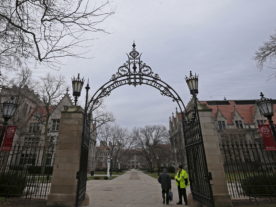







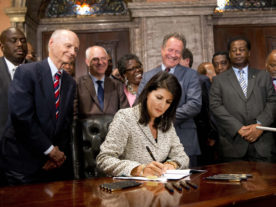

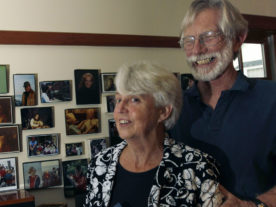


This is pure nonsense. The United States has never been more united or homogeneous than it is today. One factor that unites it is the mobility of Americans. I’ve lived in five states at various times. One of them was California. Most of the people I met in California came from somewhere else. I’ve traveled in at least 20 states and always felt at home wherever I went. They were as far apart as Maine, Florida, California, and Alaska. I never felt I was in a foreign country. I’ve been to many foreign countries and even lived in France for about two years. I was always aware I was in a foreign country even in Canada and always felt glad and reassured to return to the US no matter which state I reentered in.
People of all points of view live in all regions of the nation. For example, President Johnson would have been as well understood and accepted in New England and the West Coast as he was in Texas. There are regional differences but they do not rise to the point where there is any rational reason to suppose any of them should be a separate country. Despite those differences a single national culture of the same core values has emerged. The mobility and communication Americans enjoy will only continue to draw them tighter together. By comparison, the forced union of Europe is exploding at the seams. We recall that in times of disaster people from one region of the US went without being asked to help those in other regions. Whether this was farmers who went to help harvest crops or help for victims of hurricane Katrina. Would something like that happen in Europe? I seriously doubt it.
I have never been in US, I hope in the future, but one thing is absolutely sure, Marcus. US is truly united.
I am typing form Poland, Europe. And as Marcus said: I am following your opinion, expressed in the last sentence. European Union is only a theory, and Europe will never be united as US is. Each nation has his own mentality, languages ( often completely different from others etc. ). How you can united something like that? No possible. Of course, as a EU we can cooperate in the trade market and other businesses, but to recognise UE as a one ,, soild body”- one nation, it is a absurd.
Have a good day
American Nations doesn’t argue that all individuals living in a given region share the same views, quite the opposite. As for America being “more united and homogenous” than ever, I think that’s in variance with the facts.
Totally agree with your statements.
You wish¡ Regional diversity cannot survive in these times of I-pad interconnectedness
Don’t listen to the oldies on their way out, see what the young are up to.
Well spoken Marcus. I feel the same. What a load of dooo…
I bought and read Colin Woodward’s “American Nations” in 2013 after learning about it on an NPR website. Woodward is to be congratulated for explaining America’s regional differences and how it is reflected in its politics at the national level. I have personally seen these regional differences in Americans I have met in Thailand. The accuracy of his description of the differences in the regions was very insightful, particular why the Deep South is so very different from Yankeedom. I have lived, been educated, and worked in these different regions and his book helped me to understand these regional differences and to understand American politics at the national level and why the Washington gridlock exists. Hopefully over time these regional differences will disappear with the younger generation, but given what happened in the church shooting in South Carolina only time will tell.
Is Dora Mekouar actually trying to endorse some kind of Russia (or China)-sponsored referendum for independence of what she’s calling “countries” here or am I missing something? Sometimes I wonder why so many Americans dislike Joseph McCarthy… especially at times like this (when you need him the most). Do they really think a new civil war is better than a guy who cleans-up after the commies?
Which state would take the initiative to secede first from the United States of America because it thinks it would be better off on its own? California? What happens to it when there are forest fires and fire fighters from all over the US don’t show up? Texas? What would happen if a Katrina type catastrophe hit Galveston and Houston and no aid came from Washington DC…even belated help? Alaska? Hawaii? They’d have to import practically everything from a foreign country, the US and would have no say at all in how the US is run. What about the mobility of labor and goods across what is now one country? Would there be border controls or separate currencies? Or would it be like the failed Euroland model?
Are any group of states negotiating to create a separate nation among themselves? No, and it’s not even being remotely considered in the current Presidential campaign. It won’t even be mentioned because it would seem ludicrous to most Americans. It would be political suicide for any candidate to speak of it even once.
There are regional differences and political differences but the core values and core culture of America is one. There is no state I wouldn’t feel perfectly at home living in and there is no foreign country I wouldn’t feel discomfort living in, even Canada.
Jarek, I agree with you and Marcus too. I’m living in Poland but my nationality is coming from Turkey so EU isnt a united and will not in future. I havent been in US but if in a country people speak same language, eat usually same dishes and share common values, there is a united, I think all countries have some diffirent cultures in their own regions.
Wow. As someone born in the U.S., I find tremendous value in Woodard’s insights. I’m from Cincinnati, where the Midlands and Appalachian cultures meet (children of German immigrants vs. Kentucky “hillbillies”), and it is fascinating to parse out the two and watch them interact–even in my own family. The voting and political attitudes in this country are especially correlated to these regional differences. A lot of the comments here contrast the U.S. “nations” to the countries of the E.U., and say if the differences aren’t as extreme, there aren’t differences at all. That’s not a logical argument. But perhaps the differences are subtle for a non-native to perceive, even if one visits or lives here. Or perhaps it’s the word “nations” that people are over-interpreting.
Connie, kind of like the Hatfields and the McCoys whose famous feud lasted for decades? Eventually even they buried the hatchet as we say (means the feud ended.) I met a member of the Hatfield family when I worked in a company in North New Jersey. Which of the eleven nations should she be connected to? The family I lived next door to when I grew up in New York City all moved to different places. One daughter moved to Providence Rhode Island. Another moved to Seattle Washington. A son moved to Denver Colorado. The parents retired to Florida. Despite the geographical distances they remained a close family we kept in touch with. This is very typical, Which nation should they belong to? For one reason or another people move around America easily, often several times within their lifetime. There are none of the qualms one might have moving to another country. A good take on America can be seen on the internet on Book TV (CSPAN-2) in an interview with former BBC correspondent for several years Justin Webb about his book “Cheers America.” Although he admits he knew nothing about America before he came here, he’s now sees himself as an “expert.” Well he got a lot of things wrong in my view but perhaps he’ll offer a different perspective. I think it’s worth watching, about half an hour.
Yes, we say “bury the hatchet,” too, Marcus. 🙂 Thanks for the tip about Webb’s program, sounds interesting. Those Hatfields are relocated Appalachians, though their children might be culturally more part of the “nations” they grow up in, like any immigrants. I’ve lived in Boston, but of course that didn’t turn me into a Yankee. Although reading Woodard’s book later helped me understand the culture that indeed was a little off from my expectations. Obviously, it is easy to move between States and there is no legal immigration involved, or language acquisition. That’s not the premise of the book. It’s simply that the historical settler patterns have created stronger regional differences than we typically recognize. It’s brilliant in my opinion. Disappointing how this insight seems to be lost to the international audience. This article also unfortunately leads with a clickbait title, since Woodard never called them “countries.” Arguing about whether these regions are actually “countries” is, well, dumb as heck, and misses the entire point.
The United States is not going to break up into different countries. This was a way to grab attention, get discussions started, interviews, and sell books. It is pure sensationalism, not a serious treatise on American political unity. We occasionally hear that someone has started a petition in this state or that for seceding from the US or from the state it’s in. When I lived it California there was talk of it breaking up into two states North and South. Recently I’ve read talk of it breaking up into six or seven states. I don’t think any of this is realistic. These petitions never go anywhere.
There is no supposition of secession in the book. That’s not what it’s about in any way.
Did anyone responding on here actually read the book? Marcus, did you?
Connie, of course I didn’t read this book. In fact I never heard of it until this posting. It seems to me the thrust of Woodward’s thesis is that the USA is comprised of 11 incompatible nations having regional cultures so divergent that they are only artificially tied together. This seems preposterous to me for many reasons. Yes there are many subcultures in the USA, some on a regional basis, but many more are not. Would you say that the culture of the African American community in New York City is substantially different from that of the African American community in Los Angeles? In Minnesota? Is the culture of the Hassidic Jewish community in Los Angeles more akin to the culture of the Hassidic Jewish community in New York City or the culture of the African American community in Los Angeles?
Until relatively recently the vast majority of immigrants came to America through gateway cities like New York. Later generations dispersed. Originally many if not most African Americans’ ancestors came to the US through the Southern colonies and later Southern states. Later they dispersed migrating to the large northern cities and then throughout the country. Their values seem far more tied to their ethnicity and their common problems than to the region they’re in. Would a Chinese American native to New York City’s Chinatown feel more at home in Harlem just a few miles uptown in Manhattan or in San Francisco’s Chinatown 3000 miles away? It seems to me the Latino communities in the US have cultures more closely tied to their country of origin than the region they live in. For example, Cuban Americans would have similar values, attitudes, political views and even food preferences in any region which are not akin to say, Mexican Americans’.
I simply don’t buy Woodward’s argument. The internal mobility and communications of Americans has just been too great to have allowed isolated cultures to develop to a significant degree independently on a regional basis. There may be a few rare exceptions such as the Amish but they are a tiny minority.
Marcus Aurelius II is reasonable . i quite agree with you .
You have read the book too, truong?
The story is very useful. I love the American writers like Harper Lee, but I can’t read just the novel ”To kill a Mockingbird”, because I don’t know a lot of the English words, but I can see that She was writing about the Southern Land of Alabama.
I don’t know if people are still reading the comments here, but I am an American born here, I’ve lived in two of these different regions and my husband has lived in three. I have not read a more accurate description of this country before this article. It is dead on. I truly don’t understand the backlash I keep reading from the various commenters here. Are you not paying attention? Do you even actually live in this country? We are most definitely a series of different cultures, and unless we can admit and understand that, we are doomed to keep repeating our mistakes.
MJ, I was also born in the US, the Bronx as a matter of fact. It doesn’t get any more US than that. I’ve lived all but 2 years of my life in the US. The US is the real United Nations with people from every country living here and over 200 languages spoken. There is no city more cosmopolitan than New York City. There are many subcultures, some based on region but most not based on region. However, the overwhelming majority have shared core values that are the same. That is what defines them as Americans. Physical mobility, a propensity to relocate from one region to another for various reasons including job opportunities, and instantaneous communications so that a shooting say in Colorado is seen in real time everywhere on every news channel in the US immediately binds the nation together. Which state or region would you have secede? Which one would want to? Only a handful of kooks even claim they want to. When I lived in California 35 years ago there was talk of it breaking up into two states over water rights. It didn’t happen. Recently I heard of talk about it breaking up into six states. That isn’t going to happen either. If the Civil War didn’t break up America, nothing will.
Marcus, I think you’re missing the point of this article. This is not about splitting the nation into different countries. This is a comprehensive study about the cultural differences unique to each area. The author has done an amazingly accurate job parsing this out county by county. This is very educational. I don’t understand the defensive reactions to this article. It’s just an educational study. It is not inciting succession.
MJ I think you are missing the point I’m trying to make. My point is that trying to break down the US population into subcultures by geographical region is absurd. It makes no sense. It doesn’t stand up to even superficial scrutiny. People like to put things and people into neat little boxes, categories. It usually doesn’t work well but categorizing Americans by geography is inane. I’m not being defensive about rejecting the central thesis of this book, I’m trying to explain why it’s wrong and give examples, and there are countless examples of why this doesn’t work. Here are a few more. The Hassidic Jews of Brooklyn NYC in New Netherlands have more in common with the Amish hundreds of miles away in the Midlands than they do with Wall Street traders who snort cocaine, live on Park Avenue, and have their own private jets just a few miles away. the superficial Real Housewives of Orange County California have far more in common with the superficial Real Housewives of New Jersey than they have with women scientists working at JPL and other High tech facilities in El Norte just miles away from Orange County. African Americans living in ghettos in Los Angeles have far more in common with African Americans living in the South Side of Chicago than they do with Hollywood Stars just a stone’s throw away in Beverley Hills. And there are a thousand more.
There are subcultures in the US. Football fans, car collectors, hunters, soccer moms, compulsive gamblers, rock musicians, BBQ chefs, train lovers, but they are not broken down by geographic region. Of all methods of trying to pigeonhole Americans into categories, this method of subdividing it into 11 countries is ridiculous. It is the product of a simplistic mind who appears to know nothing about America. If I were a foreigner, I might believe it but I’ve been to these places, lived in them and I know first hand this book got it wrong.
Hi I dont know if anyone is still here but I live in southern Indiana and the city that I live in was founded by Germans and we have a very German culture, this being said, according to this my region is predominantly Irish and Scottish however living here I can defiantly assure you that there are more German speaking people than there are red headed scots. I found the idea of this book interesting though and I enjoyed reading all the arguments in the comments but Marcus is right in my opinion. Sorry if I upset anyone
Reminds me of the Nine nations of North America that Joel Garreau wrote in the 80s
Having lived in one of these nations and visited others, the theory appears accurate.
I am a traveling repair technician for a big-box store corporation, working in towns with populations ranging from a few thousand to several million, over eleven states. I travel 3-4 days a week. My remarks are based on that experience.
In the larger Cities, like Chicago and Minneapolis, I find Marcus is right.
In the less populated spaces, I find Woodward is correct.
For over a year I’d been puzzling over why Rockford Illinois looks and feels like a typical part of Minnesota/Wisconsin (my own homeland), but Quincy Illinois has a look, feel and accent shift I would have expected for Kentucky, and Dixon Illinois (Ronald Regan’s homeland) is something else yet again, a combination of seeming opposites one finds in Laura Ingalls (Little House) and Norman Rockwell books, yet strangely familiar and homelike at the same time.
The moment I saw Woodward’s map, and realized his Illinois boundary points aligned very closely with my own observations, I knew he was onto something at least partially true.
I have bought the Kindle/Audible edition of the book, and am reading and listening to it as I travel. At every step, one more thing that never quite made sense to me before suddenly falls into place, whether it’s about family squabbles (Appalachian vs. Yankee attitudes have been key drivers there), the origin of Utopian ideas in my own Minnesota/Wisconsin culture, or the present-day struggles on the National Stage.
Frankly, it is also giving me the impression that the Utopian ideals of Yankeedom, which are the cultural roots of my own ideals, are under heavy and coordinated attack by advocates of more Appalachian/Southern ways of thinking, and may actually be loosing very badly.
Look at the recent political struggles/scandals in Michigan, Wisconsin and Illinois: there is a clear and present drive away from functional Democracy, which Yankeedom has always favored in one form or another, and towards a concentration of power in the hands of a few wealthy “Lords” and their appointed “Managers”, much like the ideals of the old Deep South or Tidewater. This is being accomplished in the name of “freedom” and “small government”, which have long been the ideals of Appalachia, a region which tends to align with Lords and Managers it sees as less intrusively “meddlesome” than “big government”. Ultimately, this will backfire for Appalachia: if Yankeedom falls to Deep South ways of doing things, the result for most American citizens will be, at best, Privileged Liberty that can be revoked at any time, not actual Freedom (another important distinction Woodward makes very well).
I consider the above paragraph relevant to the current Presidential election as well.
Move over Howard Zinn: Colin Woodward is way ahead of you.
Hi,
I agree to Woodart up to a certain limit. I’ve seen 25+ states of the U.S. I see -small- regional differences as well. The differences are not very big and they are absolutely not “zero”. Go to a TX village and compare it with a village in Wisconsin. It IS different. But this is not a mistake or a U.S. failure – it’s history. Our history! We shall preserve it and develop it the best way we can.
The United Staters is a great country; it is a world born some 250 years ago and contains every country from Afghanistan to Zimbabwe. My Dad is from NYC and that place is even more a wonderful big melting pot of rich cultures with Pizza, Leberkas, Baguette, Paella, Sushi, and everything one can imagine. In fact you can say I was raised in a place of the 22nd century compared to low-speed places or Europe. Wait another 250 years and see what happens then.
I have love US ever sine I was born but never had the opportunity to visit. I hope one day, one of this birds of the sky will carry me to such a wonderful land